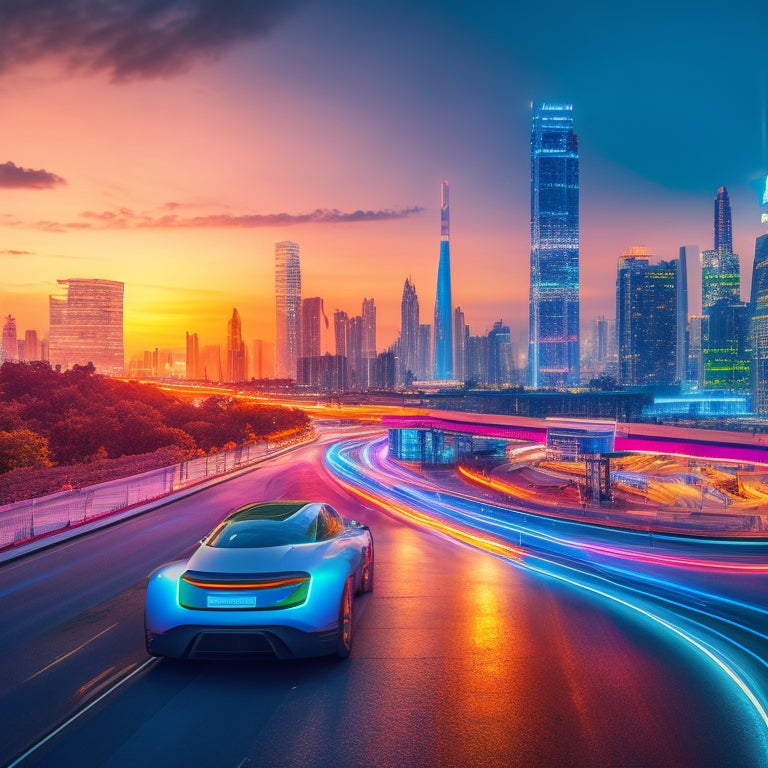
Electric Vehicle Revolution Reshaping Automotive Landscape
Share
As you navigate the rapidly shifting automotive landscape, it's clear that electric vehicles are revolutionizing the industry, driven by technological breakthroughs, shifting consumer preferences, and regulatory changes that are paving the way for a predicted 45% global EV adoption by 2030-2035. Disruptors like Tesla are gaining market capitalization, surpassing traditional dealerships and OEMs. To stay ahead, understanding the driving forces and overcoming challenges like high battery costs and limited charging infrastructure is essential. As you explore the EV landscape, you'll uncover the key factors reshaping the industry and discover how stakeholders can thrive in this new era.
Key Takeaways
• The electric vehicle (EV) market is driven by technological advancements, shifting consumer preferences, and regulatory changes promoting sustainable mobility.
• 17 public and 4 private EV OEMs are driving market growth, with disrupters like Tesla and Carvana surpassing traditional dealerships and OEMs in market capitalization.
• Projections suggest 45% global EV adoption by 2030-2035, with regulatory changes, shifting consumer mindsets, and technological breakthroughs fueling growth.
• Despite ongoing challenges like chip shortages, high battery costs, and limited charging infrastructure, innovative charging solutions and battery innovations are emerging to address hurdles.
• The EV revolution is reshaping the automotive landscape, with stakeholders needing to understand key factors to stay ahead in the evolving market.
EV Market Overview and Trends
As the automotive industry navigates disruptions from autonomous driving, connectivity, and mobility services, the electric vehicle (EV) market is emerging as a significant force, driven by 17 public and 4 private EV original equipment manufacturers (OEMs) and fueled by technological advancements and shifting consumer preferences.
You're witnessing a seismic shift in the EV market dynamics, with market capitalization of disrupters like Tesla and Carvana surpassing traditional dealerships and OEMs.
With future predictions indicating 45% EV adoption globally by 2030-2035, the industry is poised for exponential growth. Europe, the US, and China have set ambitious targets for EV sales by 2030, with major OEMs committing to zero-emission vehicles and significant EV investments.
As you navigate this landscape, it's essential to understand the EV market trends shaping the future of mobility.
Driving Forces Behind EV Growth
You're witnessing a convergence of factors driving the rapid growth of the electric vehicle market, with regulation changes, shifting consumer mindsets, and technological breakthroughs all contributing to this upward trend. Regulatory changes worldwide are promoting sustainable mobility, with governments setting ambitious targets for EV adoption. Meanwhile, shifting consumer mindsets are driving demand, with over 45% of consumers considering buying an EV.
| Driving Force | Description |
| Regulatory changes | Governments promoting sustainable mobility |
| Consumer mindset | Shifting towards sustainable mobility |
| Technological breakthroughs | Advancements in autonomous tech and battery development |
These driving forces are propelling the EV market forward, with projections suggesting 45% EV adoption by 2030-2035 globally. As the market continues to evolve, understanding these key factors is essential for stakeholders looking to stay ahead of the curve.
Overcoming Challenges in EV Adoption
While the electric vehicle market is poised for significant growth, several challenges must be addressed to facilitate widespread adoption, including the ongoing chip shortage, high battery costs, and limited charging infrastructure.
As you navigate the EV landscape, you'll find that overcoming these hurdles is important for mass adoption. To tackle these challenges, you can expect to see innovative charging solutions emerge, such as fast-charging corridors and urban charging hubs. Additionally, battery innovations will play a key role in reducing costs and increasing range anxiety.
Frequently Asked Questions
How Will Dealerships Adapt to Changing EV Sales and Service Models?
You'll need to adapt your dealership to the changing EV sales and service models by undertaking a dealership overhaul, including a sales shift, training needs, customer education, showroom revamp, and service evolution to stay competitive.
Will EV Adoption Affect Traditional Automotive Industry Job Roles?
You're "burning the midnight oil" to stay ahead in the automotive industry, but will EV adoption spark a workforce shift, disrupting traditional job roles? Yes, it will, as supply chain disruption and electrification transform the industry's labor landscape.
Can Existing Gas Stations Be Converted Into EV Charging Hubs?
You can revamp existing gas stations into EV charging hubs, leveraging urban retrofit opportunities to diversify fuel options and create a commercial opportunity, but it'll require significant investments in charging infrastructure upgrades.
What Is the Environmental Impact of EV Battery Recycling?
As you consider the environmental impact of EV battery recycling, you'll find that closed loop systems, supply chain transparency, and addressing material scarcity are essential to minimize waste and maximize energy efficiency in recycling infrastructure.
Will EVS Become More Affordable for Low-Income Households?
As you navigate the road to sustainable mobility, you'll find that EVs can become more affordable for low-income households through government incentives, financial assistance, and decreasing battery costs, paving the way for a more inclusive eco-friendly future.
Related Posts
-

Why Choose Recycled Paper for Earth-Conscious Business?
By choosing recycled paper, you'll greatly reduce your business's environmental impact. You'll lower your carbon foot...
-

5 Efficient Air Circulation Methods for Green Homes
You can utilize the power of natural ventilation techniques, whole house fans, and solar-powered ventilation systems ...
-

Green Deck Options: Earth-Conscious Choices for Your Home
You're looking for a deck that not only enhances your home's exterior but also aligns with your eco-friendly values. ...


